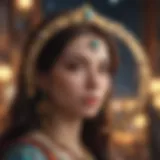Exploring the Significance of Numbers in Tarot
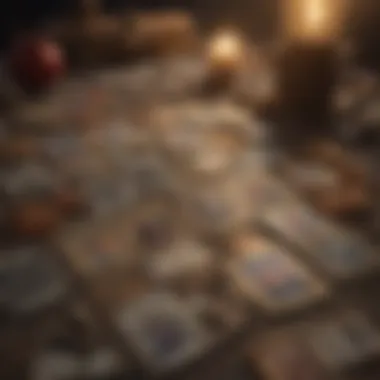

Intro
The interaction between numbers and tarot is profound yet often overlooked. This relationship offers important insights into the meanings behind tarot cards, enhancing the interpretive processes used by practitioners. Numbers are more than just symbols; they serve as beacons of significance, guiding the understanding of energies and archetypes represented in the tarot. Exploring the intricate connection between numerology and tarot allows for a deeper appreciation of how these elements can influence readings and personal reflections.
By investigating the value each number holds and how it relates back to specific cards within the tarot deck, one can uncover layers of meaning that might be hidden at first glance. Throughout this exploration, we will discuss essential numerological concepts, delve into the attributes distinct to single and multi-digit numbers, and illustrate how these numerical facets converge with the tarot's imagery and insights.
Understanding this dynamic is crucial in gaining clarity in tarot readings, as it reveals not only the character of the cards involved but also the resonance of the question posed. This article aims to provide readers with a roadmap for navigating the significance of numbers in the practice of tarot, ensuring a well-rounded and informed approach to readings.
The Role of Numbers in Tarot
Numbers play a crucial role in the realm of tarot. They serve as a hidden language that adds layers of meaning to each card. Understanding this relationship enhances interpretative depth and provides insights that might be otherwise missed. The numerical values help to categorize the cards, allowing practitioners to discern patterns and connections. Therefore, engaging with numbers is not just an abstract concept; it is an essential practice for effective tarot reading.
The significance of numbers is multifold. First, each number carries its own energy and symbolism, which interacts dynamically with the tarot's imagery. This can influence the reader's understanding during a session. For instance, a card associated with the number five may reflect conflict, while one associated with the number two might denote balance and partnership. Recognizing these nuances can lead to more accurate interpretations.
Additionally, numbers facilitate the communication of complex concepts and spiritual ideas. They serve as anchors that help organize the randomness of the tarot into coherent frameworks. Practicing numerology alongside tarot can also deepen intuition and encourage a more holistic approach to readings.
In summary, the role of numbers in tarot is profound. It involves understanding not only the individual meanings of numbers but also how they interconnect within the tarot system. This understanding is valuable for anyone seeking to navigate the intricate world of tarot with greater clarity.
Understanding Numerology
Numerology is the study of numbers and their meanings. In the context of tarot, it provides a structured way to interpret the numerical values attached to the cards. Each number, from one to ten and beyond, has its own specific attributes. This framework is not a mere coincidence; it is an ancient practice rooted in various spiritual traditions.
For instance, single-digit numbers often symbolize primal forces and themes. The number one represents unity and beginnings, while the number nine reflects completion and spiritual enlightenment. Master numbers like eleven and twenty-two denote higher vibrational energies and are significant in personal growth and potential.
Understanding numerology enhances the meaning of individual tarot cards. It allows practitioners to draw parallels between the numeric value of a card and its position within a spread. The interplay between numerology and tarot deepens one’s ability to interpret readings.
The Connection Between Numbers and Tarot
There is a direct connection between numbers and tarot that manifests on several levels. Each card in the tarot deck can be assigned a number, which is not only a means of organization but also a vital component of its energetic makeup. This connection allows for a layered analysis during readings.
The Major Arcana cards are particularly informative as their numeric sequence reveals important developmental stages of the human experience. For example, the transition from The Fool, numbered zero, to The World, numbered twenty-one, outlines a journey of growth and self-realization.
Furthermore, in the Minor Arcana, the suits also contribute numeric symbolism but in terms of daily experiences and practical life situations. Understanding how these numbers align across different suits can reveal immediate or future challenges faced by individuals.
"The intersection of numbers and tarot holds the key to enhanced intuitive readings, allowing practitioners to tap into deeper layers of insight."
The connection between numbers and tarot is essential for anyone who desires to elevate their tarot practice. It invites readers to reflect on how numerical energy influences their interpretations and interactions with the cards.
Basic Principles of Numerology
Understanding the basic principles of numerology is crucial for interpreting tarot readings. Numerology provides a structured framework that enhances the meaning associated with each tarot card. By examining numbers, one gains insight into the deeper significance of the imagery and symbolism found in the cards. This goes beyond surface interpretations, leading to a richer and more nuanced reading experience.
Single-Digit Numbers
Single-digit numbers hold a special place in numerology. These numbers, ranging from one to nine, embody distinct energies and characteristics. Each number encapsulates a specific vibration or essence that influences how tarot readings are perceived.
- Number One - Represents new beginnings and individuality. It signifies ambition and drive, often seen in the card of The Magician.
- Number Two - Embodies duality, partnership, and balance. The High Priestess reflects this number's essence by emphasizing intuition and dual aspects.
- Number Three - Symbolizes creativity, expression, and joy. The Empress often exhibits this number’s traits through fertility and abundance.
- Number Four - Represents stability and foundations. The Emperor exemplifies this by showcasing authority and structure.
- Number Five - Highlights conflict, change, and challenge. This number is evident in the challenges faced in The Hierophant's teachings.
- Number Six - Symbolizes harmony, healing, and domesticity. It resonates with The Lovers, promoting unity and connection.
- Number Seven - Represents introspection and deep understanding. The Chariot embodies this through control and mastery over self.
- Number Eight - Stands for power, success, and material wealth. Strength often reflects this with a focus on inner courage and resilience.
- Number Nine - Embodies completion and humanitarian efforts. The Hermit often signifies this number, showing the journey towards inner wisdom.
Understanding these numbers helps interpreters dig deeper into their readings. By reflecting on the meanings behind the single-digit numbers, tarot readers can unlock layers of understanding within their practice, leading to more effective guidance for those seeking insights.
Master Numbers
Master numbers, specifically 11, 22, and 33, deviate from the basic principles of single-digit numerology. They are often seen as possessing a higher potential and vibrational frequency. These numbers are imbued with complexity and heightened significance, often interpreted as keys to deeper spiritual understanding.
- Number Eleven - Known as the number of intuition and insight. Often associated with the connection between the spiritual and material realms, it emphasizes vigilance and awareness.
- Number Twenty-Two - Seen as a powerful builder and manifester. This number resonates with the energy of transformation and creativity, often linked to The Fool’s journey.
- Number Thirty-Three - Represents compassion and selflessness. It is often considered a master teacher, emphasizing the importance of using knowledge for the greater good.
Interpreting these master numbers within tarot readings requires careful consideration. Their presence infers a deeper journey for the querent, where lessons extend beyond ordinary life experiences. The integration of these master numbers can often elevate a reading from mundane to truly transformative.
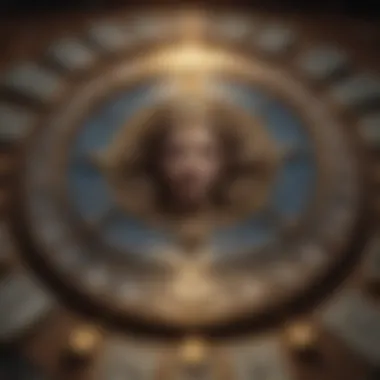

The Emphasis on the Major Arcana
The Major Arcana represents a fundamental aspect of tarot where each card carries its own distinct numerical significance. This section emphasizes not only the importance of these cards but also how their numbers contribute to their deeper meanings. In tarot, the Major Arcana consists of twenty-two cards, each corresponding to a specific theme or lesson in human experience. These cards are often regarded as the heart of the tarot deck due to their profound implications in readings.
While tarot readings frequently focus on the practical or immediate issues in life, the Major Arcana cards bring a wider, more universal contextuality. Their numbers serve as a guiding hand in extracting the essence of each card’s message. For example, the Fool is numbered zero, symbolizing potential and infinite possibilities. This positioning highlights the nature of beginnings, inviting the seeker to embrace new adventures without preconceptions.
The Numbered Cards
The numbered cards of the Major Arcana comprise cards ranging from The Fool (0) to The World (21). Each card reflects archetypes and stages of personal development, which is enriched by its number's significance. The simplicity of their design belies the complexity of their meanings.
- The Fool (0): Potential, beginnings
- The Magician (1): Willpower and manifestation
- The High Priestess (2): Intuition and mystery
- The Empress (3): Creativity and nurture
- The Emperor (4): Authority and structure
- The Lovers (6): Relationships and duality
- The Wheel of Fortune (10): Cycles and change
- The World (21): Completion and unity
Numbers in this context provide a pathway for interpretation, helping to uncover layers of meaning in relationships and personal quests. Understanding the numerical values of these cards makes it possible to draw connections to the tarot's narrative.
Symbolism of the Major Arcana Numbers
Each number in the Major Arcana is steeped in symbolic meaning, reflecting themes that resonate beyond the individual cards. Here's a basic breakdown:
- 1 (Unity): Represents beginnings, action, and leadership.
- 2 (Duality): Represents balance, duality, and relationships.
- 3 (Growth): Emphasis on creativity, development, and fertility.
- 4 (Stability): Represents structure, stability, and foundations.
- 5 (Conflict): Often suggests struggle and change, indicative of challenges faced.
- 21 (Completion): Denotes a sort of full circle, signaling achievements and fulfillment.
Numbers also illustrate cyclical patterns present in life experiences. The 22 Major Arcana cards reflect significant milestones in a person's journey, where each step contributes to one’s spiritual evolution.
"Understanding the relationship between numbers and tarot cards opens the door to deeper insights, providing clarity and direction in readings."
In summary, the emphasis on the Major Arcana reveals how numbers not only define the identities of the cards but also guide readers in interpreting profound life lessons, enhancing their understanding of tarot readings.
The Minor Arcana: A Numerical Perspective
The Minor Arcana consists of the cards that represent day-to-day events in the seeker’s life. Unlike the Major Arcana, which focuses on significant life lessons and themes, the Minor Arcana delves into the more mundane aspects of experience. Each suit within the Minor Arcana carries its own numerical significance, providing a lens through which to interpret the subtler energies at play in tarot readings. Here, understanding the numerical roots of the four suits will enhance both readability and interpretation.
The Four Suits and Their Numerical Roots
The Minor Arcana is divided into four suits: Wands, Cups, Swords, and Pentacles. Each suit aligns with a specific element and encompasses numbers from Ace to Ten, along with the Court Cards.
- Wands: Associated with the element of fire, Wands represent creativity, action, and ambition. The numerical values here show different stages of growth. For instance, the Ace signifies new beginnings while the Five often relates to conflict or competition.
- Cups: Representing the element of water, Cups focus on emotions, relationships, and connections. Starting from the Ace of Cups, which symbolizes potential and new emotional journeys, to the Ten of Cups, signifying emotional fulfillment, each number reflects the progression of one’s emotional life.
- Swords: Linked to the element of air, Swords deal with thoughts, conflicts, and challenges. The Ace of Swords typically indicates clarity or a new way of thinking, while the Five of Swords can represent defeat or tension.
- Pentacles: Associated with the element of earth, Pentacles relate to material aspects, including work, finance, and health. They begin with the Ace, representing opportunities or new ventures, progressing through to the Ten, which suggests stability and wealth.
Each of these suits embodies a unique numerical essence that helps readers gauge the prevailing energies surrounding practical matters and emotional states.
Interpreting Court Cards Numerically
Court cards within the Minor Arcana, namely Pages, Knights, Queens, and Kings, also have their own numerical implications. In many tarot systems, these cards correspond to numbers 11 through 14, representing different phases or levels of maturity within a characteristic.
- Pages (11): They symbolize newness and exploration. They are often seen as messengers or students of their suit.
- Knights (12): Eager and action-oriented, Knights represent movement and the quest for knowledge or experience.
- Queens (13): The nurturing aspect of each suit, Queens embody wisdom and intuition, having mastered their associated elements.
- Kings (14): The Kings symbolize authority and completion, representing the ultimate mastery of their suits.
Understanding these numerical assignments allows readers to interpret the Court Cards in a nuanced manner, focusing on how these roles interact within a reading. A Court Card appearing in a spread can shift both the tone and direction of the interpretation based on its numerical position within the suit.
By exploring the numerical aspects of the Minor Arcana, readers gain deeper insight into the subtleties of tarot readings. This numerical approach enhances both personal understanding and interpretative accuracy, making the reading experience more meaningful.
Numerical Values and Their Interpretations
Understanding the numerical values in tarot is crucial for anyone who seeks deeper insights through their readings. Numbers serve as more than mere symbols; they embody meanings and energies that can significantly influence interpretations. This is particularly relevant for tarologists who aim to provide unique insights catered to each individual's situation. Knowing the significance of numbers enriches the reading, allowing it to resonate more with the querent.
By recognizing how numerical meanings shape the context of each card, readers can better grasp the complexities of the tarot's narrative. Certain numbers can indicate themes such as beginnings, endings, challenges, or harmony. Tarot enthusiasts must not overlook the power of these values, as every digit offers a distinct layer to the interpretation.
Zero: The Fool's Journey
The number zero holds a special significance in tarot, closely associated with The Fool card. It symbolizes potential and the essence of beginnings. Zero represents a blank slate, the start of a journey where anything is possible. This card invites individuals to embrace uncertainty and step into the unknown.
It signifies the freedom of being unbound by past experiences. In readings, a presence of the Fool and its numerical representation may suggest a need to take risks or explore new paths without fear. The absence of limitations can bring profound growth and transformation.
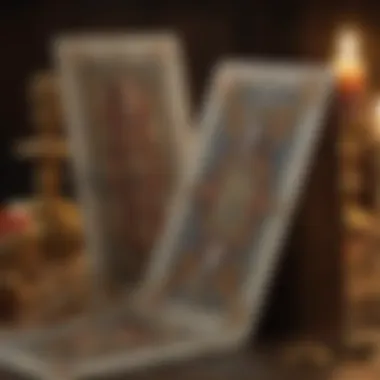

Unity: The Magician's Power
Moving to the number one, we find unity and power embodied in The Magician card. This number represents the self and the ability to act with intention. The Magician is a connector of both spiritual and material realms, emphasizing the importance of focus and will. The number one encourages individuals to tap into their inner resources, thereby manifesting their desires and goals.
When one appears in a spread, it often signals empowerment or readiness to take action. This number suggests that while all elements may align, the true catalyst for change comes from the querent's choices and mindset.
Duality: The High Priestess's Wisdom
The number two introduces duality, represented vividly by The High Priestess. This card embodies intuition, mystery, and the balance between consciousness and the subconscious. The number two reminds us that understanding often lies beyond logic and may require deep introspection.
When Two appears, it may reflect a need to delve into relationships or explore inner thoughts. It can also imply a need to weigh options carefully, as duality often brings conflicting elements that must be managed. The insight of the High Priestess encourages reliance on one’s intuition to navigate through these complexities.
Balance: The Empress and Emperor
The emergence of the numbers three and four commonly aligns with The Empress and The Emperor, respectively. The number three symbolizes growth, creativity, and the nurturing aspects of The Empress. It represents harmony between mind, body, and spirit.
Conversely, the number four symbolizes stability, structure, and control, traits embodied by The Emperor. This juxtaposition highlights the importance of balance in life and within oneself. In readings, these cards indicate the necessity to find equilibrium between creativity and order, emotion and logic.
Conflict and Struggle: The Five
The number five expresses themes of conflict and struggle, often illustrated by cards such as The Hierophant or Five of Wands. It reflects personal and external conflicts, growth through adversity, and the challenges associated with change. It is a reminder that struggle can lead to learning and development.
In particular, the presence of five in tarot readings may signify clashes requiring reflection and resolution. Rather than evoking fear, this number encourages an understanding that growth often comes from navigating through difficulties.
Overall, the numerical values in tarot are vital to interpretation. Each number embodies a unique energy and message, enhancing and influencing how a reading unfolds. Keeping these meanings in mind is essential for any tarot practitioner wishing for a comprehensive understanding of the cards.
Interpreting Personal Numbers in Tarot Readings
Interpreting personal numbers in tarot readings is a crucial aspect that can significantly enhance the depth and relevance of a reading. Personal numbers, particularly those derived from one’s birth date or name, often hold distinctive meanings that resonate with individual life paths. They bridge the gap between broader numerological principles and the intimate circumstances of the seeker. Utilizing personal numbers allows the reader to tailor interpretations specifically for the individual, enriching the reading experience.
Personal numbers provide context. Knowing a client’s personal number can allow a tarot reader to connect the meanings of the cards drawn to the client's unique life's journey. This approach can reveal patterns or highlight lessons specific to that individual, helping to create a more personalized narrative.
- Benefits of Using Personal Numbers:
- Enhances clarity in readings.
- Highlights personal challenges and strengths.
- Adds layers of meaning to each card interpretation.
By integrating personal numerology, readers can connect more deeply with the cards, allowing for a nuanced approach that goes beyond general meanings. This connection not only aids the reader but also provides comfort and understanding for the person receiving the reading.
Calculated Personal Numbers
Calculated personal numbers are derived through specific techniques often involving one's birth date or name conversion using numerology principles. These numbers serve as foundational elements in tarot readings.
For example, to calculate the Life Path Number, a person’s birth date can be reduced to a single digit or a master number. This number reflects their core personality and life experiences. Here’s how it can be done:
- Break down the birth date into its components (day, month, year).
- Add those numbers together.
- Continue reducing until achieving a single digit or a master number (11, 22, 33).
Each resultant number carries its own significance:
- 1 signifies new beginnings.
- 2 represents duality and partnership.
- 3 is about creativity and joy.
These calculated personal numbers can then act as focal points during a tarot reading, emphasizing aspects of the seeker’s life journey that are particularly relevant.
How Personal Numbers Influence Readings
Personal numbers have the potential to drastically influence tarot readings by shaping interpretations toward the routines and challenges faced by the querent. The understanding of an individual’s personal number can clarify the reading’s direction and reveal specific themes that the seeker needs to confront.
- Personal Alignment: When a personal number aligns with a card drawn, it can indicate an affirmation of the path. For instance, if a tarot card signifies movement and the querent's number also links to progress, it is a strong reinforcement of direction.
- Identifying Patterns: Recognizing the intersection between personal numbers and tarot symbols can help spot patterns. If a particular number frequently appears, it signals an important lesson or recurring theme in one’s life.
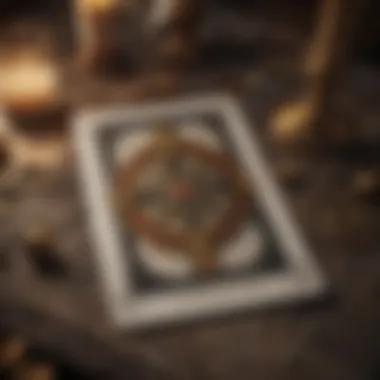

"Understanding how personal numbers resonate with tarot cards opens new pathways of insight and meaning for readers and seekers alike."
Using personal numbers can shift a reading from a generalized interpretation to a targeted counsel reflecting life’s nuances. This engagement deepens the connection and enriches the clarity of guidance provided through tarot.
Advanced Numerological Techniques in Tarot
Advanced numerological techniques offer a deeper insight into tarot readings, enhancing the accuracy of interpretations. By integrating numerology into tarot practice, practitioners can better understand the energies and influences at play during readings. This exploration helps uncover patterns and connections within the cards, allowing for a more informed reading experience. Several specific methods can be employed, and each carries its unique benefits.
Combining Numerology with Tarot Spreads
The fusion of numerology with tarot spreads enriches the interpretative spectrum. Each tarot spread is designed with a specific purpose. By assigning numerical values to the positions of the cards, the reader can derive additional meanings.
- Position Significance: Each card's position in a spread can reveal a specific aspect of the querent's situation. The number of the position often correlates with the themes tied to that number in numerology.
- Card Interaction: How cards relate to their positions can form a story, guided by the underlying numerical themes. For instance, if a card associated with conflict is in a position of personal circumstances, it suggests a specific focus on struggle.
- Clarity Through Patterns: Recognizing patterns in the presence of certain numbers across different positions can direct focus. For example, if multiple cards representing ‘3' appear, it may signify themes of creativity or collaboration.
Numerological Patterns in Readings
Numerological patterns are essential for deepening tarot interpretations. Observing recurring numbers adds layers to the analysis. These patterns can emerge in the following ways:
- Card Count: The sum of the numerical values of drawn cards can lead to insights. Simplifying this total into a single-digit number unveils further connections to traditional numerology.
- Frequency Analysis: Tracking numbers repeating across sessions or various readings can highlight persistent themes in a querent’s life.
- Contextual Application: Different reading contexts may yield varying interpretations of the same numeric patterns. For example, the number '8' can symbolize power and balance, but in a reading focused on finances, it may emphasize wealth or material challenges.
In essence, advanced numerological techniques in tarot not only enhance the reading process but also empower practitioners. By using these methods, tarot readers can offer a more nuanced understanding of the cards, assisting querents in their journey towards clarity and insight.
Case Studies: Real-Life Examples
Case studies provide concrete illustrations of how the theoretical aspects of numbers in Tarot manifest in actual readings. By examining specific instances, readers can grasp not only the practical implications of numerology in Tarot but also the nuances involved in interpretations. These examples serve as a bridge between abstract concepts and real-world applications, making them invaluable in understanding the subject more deeply.
Analysis of Notable Tarot Readings
In this section, we will analyze several noteworthy tarot readings where numbers played a pivotal role. These cases highlight how numerological significance can bend meanings and perceptions during a reading.
- Personal Reading of the High Priestess
In one notable case, a professional tarot reader conducted a session for a client seeking guidance on their spiritual journey. The reader drew the High Priestess card, which was accompanied by a numerology of 2. This number emphasizes intuition and duality. The reader interpreted this combination to imply that the client needed to trust their inner voice and balance rational thought with emotional insights. The result was a profound realization for the client about their decision-making process in life. - Job Reading With Five of Pentacles
Another example involves a client anxious about job security. The reader pulled the Five of Pentacles, a card associated with conflict and struggle, represented by the number 5. The interpretation stressed the challenges the client faced. Despite its negative connotation, the reader also offered a path forward, suggesting the number 5 can symbolize necessary change. The client left with a clearer perspective on taking action and adapting to circumstances. - Relationship Reading Featuring the Lovers
A couple seeking relationship advice pulled the Lovers card, which resonates with the number 6. This number symbolizes harmony and balance, suggesting a perfect match. The reading discussed how their differing perspectives could create tension. Still, the emphasis was on unity, encouraging both to lean into their strengths all while understanding their individuality. This idea preserved their bond and led to an open discussion about their future together.
These case studies show how numbers connect with specific cards and how they influence the readings. Each interpretation emphasizes richer meanings by grounding them in real-life situations. It demonstrates the significance of being open to how numerology and tarot intertwine.
Lessons Learned from Numerical Interpretations
With each case study, there is a lesson to be absorbed from how numbers shape readings in Tarot. Understanding these lessons can enhance one's practice and offer more informed insights during readings.
- Numbers Guide the Narrative: In every reading, specific numbers played a crucial role in guiding the overall narrative. A card's number can reveal deeper emotional or spiritual themes that might not be immediately visible. This insight demonstrates the need to appreciate numerology alongside traditional card meanings.
- Patterns Emerge Over Time: As readers collect more experiences, patterns begin to emerge from numerical interpretations. Repeated themes can illuminate personal growth and indicate recurring life lessons, making the analysis of past readings beneficial for both readers and clients.
- Client Awareness is Key: When conducting readings, awareness of how numbers interact with cards can empower clients. It engages them in the interpretation process, guiding their reflections on personal growth and future action.
“Numbers in Tarot are not just symbols to memorize; they are keys to deeper understanding.”
These lessons inform and challenge readers as they grow in their craft, shifting their focus toward a more holistic approach in tarot practices. Through case studies and direct applications, practitioners become more adept at navigating the intersection of numerology and Tarot.
Culmination: Reflecting on Numbers in Tarot Practice
The exploration of numbers within tarot practice reveals a profound layer of meaning that often remains obscured to the untrained eye. The intricate relationship between numerology and tarot enhances the interpretative possibilities of each card. Understanding this connection is not merely an academic exercise; it shapes how practitioners perceive and engage with their decks. By contemplating the significance of each number, one gains a deeper insight that transcends the superficial reading of symbols.
Summarizing Key Insights
In summary, the key insights from this article illustrate how numerology serves as a foundational element in tarot practice. Here is a brief overview:
- Numerical Significance: Each number carries its unique attributes and energies, influencing tarot card interpretations.
- Major and Minor Arcana: Understanding the distinct roles that numbers play in both the Major and Minor Arcana allows for more nuanced readings.
- Personal Numerical Analysis: By identifying personal numbers through numerology, readers can gain insights tailored specifically to their life path and circumstances.
- Integration with Tarot Spreads: Advanced numerological techniques enable practitioners to create sophisticated spreads, enhancing the depth of readings.
As practitioners apply these insights, they create a more holistic approach to tarot reading that incorporates both numerical and symbolic dimensions. This multi-faceted understanding paves the way for richer, more meaningful interpretations.
The Future of Numerology in Tarot
Looking ahead, the future of numerology in tarot appears promising. As more individuals seek personalized and accurate readings, the integration of numerical principles into tarot practice will likely expand. Emerging trends may include the development of new spreads based specifically on complex numerological patterns.
Additionally, advancements in technology may lead to innovative tools that assist practitioners in calculating and interpreting numbers related to their tarot readings. Online resources and communities might grow, facilitating deeper discussions surrounding this intersection of numerology and tarot.
Furthermore, there is an increasing interest in esoteric studies. As more people explore the spiritual dimensions of tarot, the role of numbers will continue to gain recognition. This growing curiosity offers fertile ground for new interpretations and practices that blend traditional tarot readings with modern numerological insights.
Ultimately, integrating numerology into tarot practice enriches the reader's experience and fosters greater self-awareness, enhancing the significance of the readings themselves.




